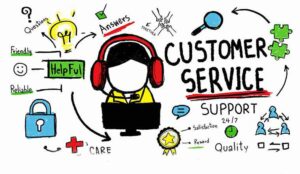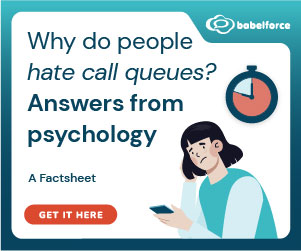Our panel of experts discuss the value of collecting customer feedback, while sharing how to best use key customer insights in the contact centre.
Importance of Collecting Customer Feedback
1. Gives Your Customers a Voice Within Your Organization

Customer feedback is at the core of every successful customer experience programme. It focuses on capturing the expectations, likes and dislikes of your customers.
In the age of social media, customers are more knowledgeable and opinionated. They’re more vocal and far more forthcoming with feedback. Ratings, reviews, tweets, comments and blogs can make or break a brand.
Yet it’s not enough to just collect feedback; it needs to be made actionable. Nothing can be achieved by gathering feedback but not acting on it.
Customer feedback matters. To build a strong relationship with customers, businesses must listen to what they have to say, do something about it and close the loop by letting them know that they have been heard.
Even though most organizations would claim that they’re customer-centric, only a few are truly delivering experiences that align with the customer voice.
Contributed by: Nikki Quinn, Senior Solutions Consultant at Playvox
2. Gives You an Outside-In Perspective
Maintaining focus on the customer means understanding what each of them wants and values, as well as delivering it to them in the form of a superior experience.
Today, it may be easy to overlook the purpose of collecting and analysing customer feedback – because not every consumer is willing to fill in an online survey or provide feedback – but we must remember that feedback is key to understanding customers’ needs.
Businesses are trying to understand what their customers do instead of what they say.
Understanding what customers do means looking at the wealth of information that comes from all channels, including social listening.
By doing this, you can identify what consumers are browsing and what tips them into a purchase.
Also, it provides a way to measure whether you are meeting your customers’ changing needs through behaviours and choices that are not always linear.
3. Provides You With an Opportunity to Take Action
Customers are more likely to provide feedback if they can see that it makes a difference. There’s no point in asking for feedback from customers if your company doesn’t have a plan to address it.
Acting on the suggestions from customers gives your business the best chance to turn a negative experience into a positive one.
Following up with customers that leave negative feedback is crucial in finding out what went wrong with an interaction and in fostering a positive relationship with a disgruntled consumer.
This is particularly important, as research conducted at Genesys in December 2019 found that 46% of shoppers will stop doing business with a company that provided them poor service and 45% share stories of their experiences with family and friends.
4. Allows You to Build Your Future on Better Decisions

More than ever, businesses need to make educated decisions about their priorities. There is no place for loose guesses in today’s competitive market.
From sales numbers to customer feedback and other information, managers and executives use data from multiple sources to develop future strategies.
But data derived from customer feedback is perhaps the most reliable and honest form of information that your business will have.
These customer insights will allow you to make decisions that can help you direct your resources to align the service experience you deliver with your customers’ expectations.
Whether comments about your products, services and experiences are positive or negative, it’s important to take them seriously and use them in shaping your strategy for moving forward.
Contributed by: Brendan Dykes, Senior Director of Solutions and Product Marketing at Genesys
5. Not Only Helps Customer Service, but the Business as a Whole
Customer feedback is the best source for inspiring marketing and sales decisions, as well as helping you craft better strategic decisions about your product and service offering.
Being in the midst of a business often makes discovering problems a difficult task. However, when you ask for customer feedback, you get an outside perspective of the situation.
A third party looking in is often better able to note your flaws and strengths, so – by noting any pain points and what it is about your products and services that excites them – you can find out how to design, sell and market to them more effectively.
Also, by taking this approach, you can better meet the needs and expectations of the customers out there you haven’t yet interacted with.
6. Proves to Your Customers That Their Opinions Really Matter

By inviting feedback, you’re communicating that you value your customers’ opinion and you care about what they have to say. As a result, your customers will feel important, because they are more involved in shaping your product and service.
When your customers are listened to and heard, a positive feeling is also reflected back to you as their supplier or service provider, which can eventually result in more sales and positive retention.
Ultimately, in today’s social media world, this is also the best way to gain valuable brand ambassadors who will spread positive word-of-mouth for you.
Their free, objective support online is probably the most effective and the most cost-effective way to acquire new customers and add value to your brand, in the eyes of both current and future clients.
Contributed by: Garry White, Head of Partners at Business Systems
7. Helps Us to Measure Key Metrics

It is not always evident to businesses that they have excellence, or that they have work to do. Collecting customer feedback allows us to put together metrics, which we can benchmark, to track improvements or highlight failures.
Take customer satisfaction as an example. Customer satisfaction programmes have evolved into a science of consumer behaviour, and often businesses track multiple indicators in their quest to attract and retain valuable customers.
Zero of these indicators would be made possible without customer feedback, whether that is direct or indirect.
Indirect feedback is when we gain a customer’s feedback without directly asking for it. So the customer talks about your company but does not have the intention of giving the information to you as “formal” feedback.
Contributed by: Matthew Lawlor, Co-Founder and CTO of Spearline
8. Helps to Build Trust in Your Brand

Trust is paramount in the customer–company relationship. Despite this, not all businesses recognize just how easily it can be lost or broken.
Whether its data breaches, privacy concerns, or poor customer service, all can be potential causes of damage, or worse yet, they can ruin a company’s trustworthiness and ultimately its relationship with customers.
It’s vital that businesses put processes in place to secure and maintain their customers’ trust, and asking for feedback is one way of doing so.
All organizations should encourage their customers to provide feedback, good or bad. Making small mistakes is an inevitability, but it is the way that businesses deal with those mistakes that sets the tone for ongoing customer relationships.
If businesses can demonstrate that their response to criticism is sensible and appropriate, existing and prospective customers can be sure that they will receive similar treatment.
Contributed by: Ian Moyse, EMEA Sales Director at Natterbox
9. Provides You With a Better Understanding of the Customer Journey

Bringing in operational data, unstructured feedback (like social media) and insights captured during conversations is important, in order to understanding the full customer journey.
Even with all that data, you don’t have a complete picture until you get direct feedback from the customer, which should be done through their preferred channel.
Invaluable direct customer feedback plays a vital role in building a positive customer perception of your brand. If done with best practices in mind, customers will perceive that you care about their experience, whether they complete the survey or not.
As a rule, your customer feedback solution should be thought of as a relationship-building tool, not just a survey.
The key to success is a solid feedback loop. Let the customer know in a timely manner that their feedback was received and what is being done with that knowledge.
In turn, this drives positive brand reception, establishes relationships and encourages more feedback.
Contributed byL Shawna Malecki, Senior Product Marketing Manager at NICE
10. Helps to Identify Customers at Risk of Churning

If a customer leaves negative feedback, that’s a danger sign. Pair that with a drop in activity and that customer is at risk.
By thinking of customer feedback in this way, it can become a retention tool, to identify customers at risk of churning and give them reasons to stay loyal.
For example, we can phone them back and blow their socks off with excellent customer service or maybe just reach out to them with an SMS message, offering a reduction on their next purchase.
We can even take this strategy to the next level with interaction analytics, which you can use to identify both the root causes of customer dissatisfaction and how agents handle these issues.
As a result, you can then develop programmes, processes and advisor training to address potential churn drivers to improve customer satisfaction and retention.
Contributed by: Frank Sherlock, VP at CallMiner
11. Enables You to Change Perceptions of the Contact Centre
When customers share their concerns, it puts the spotlight on those in customer service and the contact centres, as they expect us to act on feedback and deliver exceptional customer experiences.
Use this hard economic reality to transform the way senior managers view your own contact centre.
Promote its strategic value to drive customer experience, shifting the perception from a resource-draining cost centre to an indispensable profit centre with the power to increase revenues, boost customer loyalty and build a sustainable corporate brand.
For too long many organizations have been viewing contact centres as “cost centres”. Change that by sharing feedback with those in other departments, giving insights to those who have the power to do something about the problem.
12. Gives You the Opportunity to Engage With Your Team

Your advisors, with direct access to what customers really think, are the face, ears and voice of the company and worth their weight in gold.
With this revelation comes an opportunity to build a team of trailblazers and elevate the status of the entire contact centre.
Encourage advisors to share their knowledge and experience to promote customer service best practice across the whole organization.
Help them to instil a customer-first approach, explaining why all feedback is good to avoid a ‘head in the sand’ mentality and show how negative customer feedback can offer a great incentive to turn bad customer experiences into good ones.
To take this one step further, you can use WFM solutions to increase collaboration between advisors. These will enable the team to quickly locate colleagues and subject matter experts across the business to drive satisfying customer interactions.
Contributed by: Magnus Geverts, VP of Product Marketing at Calabrio
13. Shows Whether or Not You’re Meeting Customer Expectations

To sustain success, businesses are having to learn how to become much more customer-centric in their approach, and one of the best ways to ensure your business meets customer expectations is through harnessing the power of feedback.
By creating a systematic approach to collecting feedback, you can listen and learn from your customers. Your customers are the ones that pay for your products and services day in, day out – so what they think of your offering can potentially make or break your business.
By giving your customers a platform to tell you how well they think you’re doing, you can continually ensure you offer the best customer experience possible, while also building it into future product development.
In this time, where service levels have become one of the main differentiators between you and your competitors, even the smallest advantage can make a huge difference.
For this reason, using customer feedback to continually improve your service levels can offer the edge you need in the fight to keep ahead of the competition.
Contributed by: Tim Kimber, Director of Product Marketing at Vonage (Formally NewVoiceMedia)
14. Helps You to Spot Areas of Inefficiencies
Ignore customer feedback at your own peril. You risk losing a chance to strategize, to problem solve, and to innovate.
If a customer is taking the time to interact with you, whether it’s a complaint or a compliment, they expect you to take action. Customer feedback will show you where you may be missing the mark.
Also, while prompt and reliable customer service is a baseline requirement for every good business, customer feedback is also raw data you can turn into actionable insights.
At an aggregate level, analysing customer feedback will improve processes, services and products across your organization.
On an individual basis, customer feedback will help you identify disgruntled customers and allow you to reach out to them before they churn.
15. Provides Insights to Reduce Effort and Increase Sentiment

By paying close attention across all available channels – whether that’s a customer service call, a social media comment, or a click-to-chat interaction – you can stitch together a unified view that is integral to your decision making.
Measuring sentiment can convert disgruntled customers into brand loyalists and tracking repeated requests can become the basis for your next expansion.
Also, analysing cohesive feedback can reduce the effort your customers spend transacting with you.
There are plenty of opportunities to scale your services, optimize your resources and to transform your organization to better meet customer expectations. All you have to do is listen.
Contributed by: Shorit Ghosh, Executive XM Advisor at Qualtrics
16. Helps to Increase Customer Loyalty, if Used Well

Customer experiences drive buying decisions and are directly related to brand loyalty.
So, with loyal customers five times more likely to purchase again, according to RJMetrics, getting customer feedback to learn why they’re loyal pays off. Customer feedback is essentially one of the critical links to improving customer experiences and loyalty.
But how can you best harness customer feedback in the contact centre?
One method is to adopt dynamic adaptive surveys to engage customers and avoid survey fatigue. Another is to bring in analytics, metrics, and insights into customer behaviour to predict how customers might behave.
The bottom line is that, to shine as a business, knowing what customers think is critical. There’s no better way to get customer feedback than to ask.
Contributed by: Doron Simon, VP, GM NICE Satmetrix at NiCE
17. Creates a Picture of Your Customer Base

There’s no denying that the growth of digital channels has given customers a chance to become more and more vocal about the brands they engage with.
As a result, a good 64% expect brands to pay heed to their concerns. But are brands listening?
Customers are a business’s bread and butter, and businesses now have this excellent opportunity to build a picture of their customer base. All it takes is paying close attention to valuable data.
It is known that satisfaction surveys can help gain quick insight into the outcome of a customer service interaction, but there are ways to get more nitty-gritty detail.
Sentiment analysis and social listening tools can build a bigger picture of the customer, helping brands understand how customers are feeling at a given moment.
Also, looking at call dropout rates shouldn’t be forgotten either as they can help to identify a particular pain point.
Contributed by: Sunny Dhami, Senior Director of Product Marketing at RingCentral
18. Helps to Ensure That the Customer Is Always the Priority
Most companies are formed with a particular goal in mind, more often than not to satisfy a specific customer need.
When success starts to happen, however, organizations can lose sight of what they set out to achieve, getting waylaid by processes and metrics.
Collecting customer feedback is an essential part of keeping organizations on track with their mission and goals.
Knowing what customers need now is still as important as knowing what they needed at the beginning, and the best way to do this is to keep them in the loop and yourself up to date with their needs.
Everything should come down to the company’s mission of satisfying the customer and how it can be best served, something which cannot be achieved without input from the customers themselves.
19. Gives Us Insight Into How We Can Improve

It’s easier now more than ever for customers to leave feedback, from online and text surveys, to social media posts and comments.
What’s more, customers don’t even need to be asked direct questions any more. Gone are the days of endless paper feedback forms.
In today’s world, technology – such as speech analytics – can give companies immediate feedback on their customers’ emotions, assessing the language and tone used in phone calls and messages to illuminate customer feelings here and now.
By utilizing these tools and assessing customer experiences, we can track further avenues for customer feedback and use the learnings to improve our services and offerings.
Contributed by: Valur Svansson, CX Marketing and Sales Advisor at IP Integration
For more on collecting customer feedback, read our articles:
- 25 Good Customer Feedback Examples
- 9 Ways to Encourage Customers to Give Feedback
- 5 Places to Source Great Customer Feedback
Author: Robyn Coppell
Reviewed by: Hannah Swankie
Published On: 17th Feb 2020 - Last modified: 23rd Sep 2025
Read more about - Customer Service Strategy, Brendan Dykes, Business Systems, Calabrio, CallMiner, Clarabridge, Frank Sherlock, Garry White, Genesys, Ian Moyse, IP Integration, Magnus Geverts, Natterbox, NiCE, NiCE CXone, Nikki Quinn, Noble Systems, RingCentral, Service Strategy, Shawna Malecki, Spearline, Tim Kimber, Voice of the Customer, Vonage






































